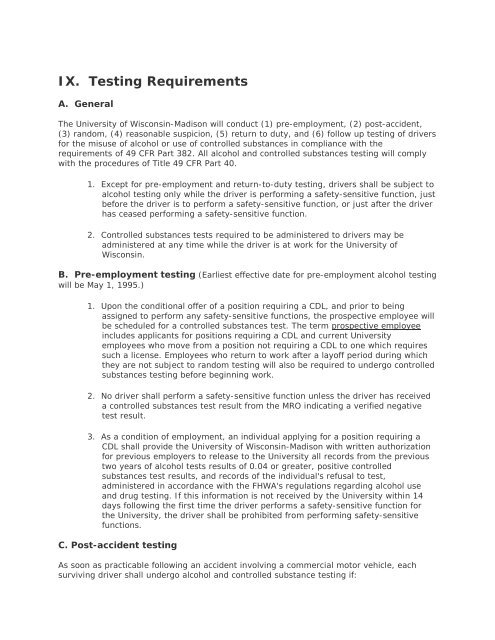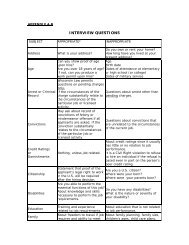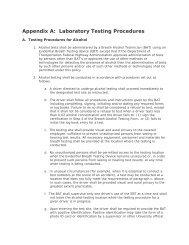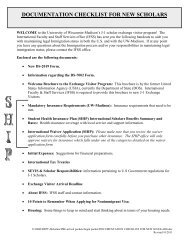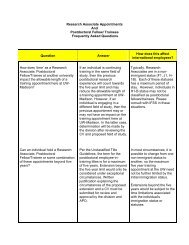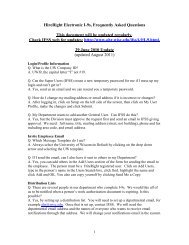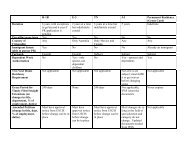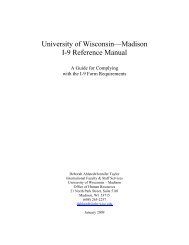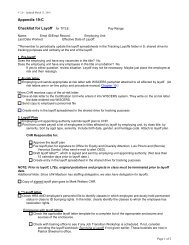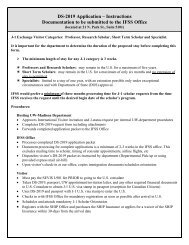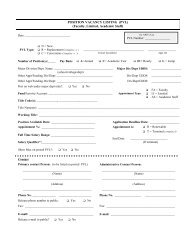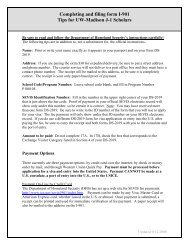IX. Testing Requirements - University of Wisconsin-Madison
IX. Testing Requirements - University of Wisconsin-Madison
IX. Testing Requirements - University of Wisconsin-Madison
Create successful ePaper yourself
Turn your PDF publications into a flip-book with our unique Google optimized e-Paper software.
<strong>IX</strong>. <strong>Testing</strong> <strong>Requirements</strong>A. GeneralThe <strong>University</strong> <strong>of</strong> <strong>Wisconsin</strong>-<strong>Madison</strong> will conduct (1) pre-employment, (2) post-accident,(3) random, (4) reasonable suspicion, (5) return to duty, and (6) follow up testing <strong>of</strong> driversfor the misuse <strong>of</strong> alcohol or use <strong>of</strong> controlled substances in compliance with therequirements <strong>of</strong> 49 CFR Part 382. All alcohol and controlled substances testing will complywith the procedures <strong>of</strong> Title 49 CFR Part 40.1. Except for pre-employment and return-to-duty testing, drivers shall be subject toalcohol testing only while the driver is performing a safety-sensitive function, justbefore the driver is to perform a safety-sensitive function, or just after the driverhas ceased performing a safety-sensitive function.2. Controlled substances tests required to be administered to drivers may beadministered at any time while the driver is at work for the <strong>University</strong> <strong>of</strong><strong>Wisconsin</strong>.B. Pre-employment testing (Earliest effective date for pre-employment alcohol testingwill be May 1, 1995.)1. Upon the conditional <strong>of</strong>fer <strong>of</strong> a position requiring a CDL, and prior to beingassigned to perform any safety-sensitive functions, the prospective employee willbe scheduled for a controlled substances test. The term prospective employeeincludes applicants for positions requiring a CDL and current <strong>University</strong>employees who move from a position not requiring a CDL to one which requiressuch a license. Employees who return to work after a lay<strong>of</strong>f period during whichthey are not subject to random testing will also be required to undergo controlledsubstances testing before beginning work.2. No driver shall perform a safety-sensitive function unless the driver has receiveda controlled substances test result from the MRO indicating a verified negativetest result.3. As a condition <strong>of</strong> employment, an individual applying for a position requiring aCDL shall provide the <strong>University</strong> <strong>of</strong> <strong>Wisconsin</strong>-<strong>Madison</strong> with written authorizationfor previous employers to release to the <strong>University</strong> all records from the previoustwo years <strong>of</strong> alcohol tests results <strong>of</strong> 0.04 or greater, positive controlledsubstances test results, and records <strong>of</strong> the individual's refusal to test,administered in accordance with the FHWA's regulations regarding alcohol useand drug testing. If this information is not received by the <strong>University</strong> within 14days following the first time the driver performs a safety-sensitive function forthe <strong>University</strong>, the driver shall be prohibited from performing safety-sensitivefunctions.C. Post-accident testingAs soon as practicable following an accident involving a commercial motor vehicle, eachsurviving driver shall undergo alcohol and controlled substance testing if:
1. the driver was performing a safety-sensitive function with respect to the vehicle,if the accident involved the loss <strong>of</strong> human life; or2. the driver receives a citation under state or local law for a moving traffic violationarising from the accident; and (a) a person is injured and, as a result <strong>of</strong> theinjury, immediately receives medical treatment away from the scene <strong>of</strong> theaccident; or (b) one or more vehicles received disabling damage as a result <strong>of</strong>the accident, requiring the vehicle(s) to be towed from the scene <strong>of</strong> the accident;or3. the supervisor determines that the use <strong>of</strong> alcohol or controlled substances mayhave contributed to the accident and requests the driver to undergo testingbased on "reasonable suspicion".D. Random testing1. No fewer than 25% <strong>of</strong> the average number <strong>of</strong> positions required to have a CDLshall undergo random alcohol testing each calendar year.2. No fewer than 50% <strong>of</strong> the average number <strong>of</strong> positions required to have a CDLshall undergo random controlled substance testing each calendar year. [Note:The minimum annual percentage rates for alcohol and controlled substancetesting may be adjusted annually by the Administrator <strong>of</strong> the Federal HighwayAdministration (FHWA). If the minimum percentage rates are changed, the<strong>University</strong> <strong>of</strong> <strong>Wisconsin</strong>-<strong>Madison</strong> will adjust its testing program to comply with thefederal requirements.]3. The selection <strong>of</strong> drivers for random testing, the timing and frequency <strong>of</strong> randomtests, and the number <strong>of</strong> drivers to be tested on any given day shall bedetermined by the <strong>University</strong> <strong>of</strong> <strong>Wisconsin</strong>-<strong>Madison</strong> through the <strong>University</strong>'svendor, General Medical Laboratories. The selection <strong>of</strong> drivers for random testingshall be made by a scientifically valid method. Each driver shall have an equalchance <strong>of</strong> being selected for testing each time selections are made.4. The testing will be unannounced and will be dispersed throughout the calendaryear.5. When randomly selected, an employee may be required to submit to either analcohol or controlled substance test, or both.6. Drivers who are notified <strong>of</strong> selection for random alcohol and/or controlledsubstances testing shall be required to proceed to the test site immediately afterbeing notified.E. Reasonable suspicion testing1. A driver may be required to undergo alcohol and/or controlled substance testing ifthe employing department has reasonable suspicion that he/she has violated theprohibitions <strong>of</strong> these rules, or if the employee's behavior and appearance indicatealcohol misuse or use <strong>of</strong> controlled substances.
2. A determination that a reasonable suspicion exists that a driver has violated thealcohol prohibitions must be based on observations made during, just preceding,or just after the period <strong>of</strong> the work day that the driver is required to be incompliance with this policy.3. No driver shall be subject to reasonable suspicion alcohol testing later than 8hours following the determination that reasonable suspicion exists to require thedriver to under go such test.4. The trained supervisor or trained management <strong>of</strong>ficial who makes thedetermination that reasonable suspicion exists to conduct an alcohol test shallnot conduct the alcohol test <strong>of</strong> the driver.5. A written record shall be made <strong>of</strong> the observations leading to a controlledsubstances reasonable suspicion test and shall be signed by the trainedsupervisor or trained management <strong>of</strong>ficial who made the observations. Thewritten record shall be made within 24 hours <strong>of</strong> the observed behavior or beforethe results <strong>of</strong> the controlled substances test are released, whichever is earlier.F. Return-to-duty testing1. If a driver has an alcohol test result indicating an alcohol concentration <strong>of</strong> 0.02 orgreater, but less than 0.04, the driver shall be prohibited from performing asafety-sensitive function for a minimum <strong>of</strong> 24 hours.2. A driver who has undergone an alcohol test with a result <strong>of</strong> 0.04 or greater orwho has a confirmed positive test for controlled substances, shall not bepermitted to perform a safety-sensitive function unless:a. The driver has been evaluated by a substance abuse pr<strong>of</strong>essional (SAP)who shall determine what assistance, if any, the driver needs in resolvingproblems associated with alcohol misuse and controlled substances use:andb. Following a determination by a substance abuse pr<strong>of</strong>essional that thedriver is in need <strong>of</strong> assistance in resolving problems associated withalcohol misuse and/or use <strong>of</strong> controlled substances, the driver hascomplied and remains in compliance with any and all prescribed orrecommended rehabilitation and/or treatment programs.c. When appropriate, the driver has undergone a return-to-duty alcohol testwith a result indicating an alcohol concentration <strong>of</strong> less than 0.02 if thedriver has violated the alcohol prohibitions; andd. When appropriate, the driver has undergone a return-to-duty controlledsubstances test with a result indicating a verified negative result if thedriver has violated the controlled substances prohibitions.e. The driver shall be subject to such return-to-duty testing for both alcoholmisuse and use <strong>of</strong> controlled substances if the substance abusepr<strong>of</strong>essional determines testing for both alcohol and controlled substancesis recommended.
G. Follow-up testingA driver who has undergone an alcohol test with a result <strong>of</strong> 0.04 or greater or who has aconfirmed positive test for controlled substances, who is subject to, and has complied withthe return-to-duty testing provisions, and who has been permitted to return to work shall besubject to the following:1. The driver must have been evaluated by a substance abuse pr<strong>of</strong>essional who willhave determined what assistance, if any, the driver needs in resolving problemsassociated with alcohol misuse and controlled substances use; and2. The driver shall be subject to unannounced follow-up testing.3. The number and frequency <strong>of</strong> such tests shall be determined by the substanceabuse pr<strong>of</strong>essional, and shall consist <strong>of</strong> at least six (6) tests in the first 12months following the driver's return to duty.4. The substance abuse pr<strong>of</strong>essional may terminate such tests at any time after thefirst six tests has been administered if he or she determines the tests are nolonger necessary. Follow-up testing shall not exceed 60 months after the driver'sreturn to work.5. The driver shall be subject to such follow-up testing for both alcohol misuse anduse <strong>of</strong> controlled substances if the substance abuse pr<strong>of</strong>essional determinestesting for both alcohol and controlled substances is recommended.


